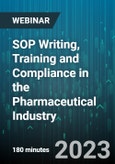Still, it is not widely understood the extent of the commitments we make when we write an SOP or how the writing of the SOP can have a positive or negative impact on training or job performance. For example, there is an expectation that procedures describe the most critical processes for product manufacturing and will be followed consistently, with few if any deviations.
In this course, you will learn the keys to writing effective SOPs, the vital connection between the documentation and training spheres, and how to maximize this connection to improve the quality of both SOPs and training. To accomplish these goals, we will review regulatory agency expectations when an SOP is written, provide suggestions for uncovering the process in its entirety and describe it clearly and concisely, indicate how to break portions of the process(es) into logical chunks and show how the SOP and the training program can work together harmoniously.
Understanding how the average employee is swamped with more work than they can manage, we will also provide tips for shortening this process and taking advantage of tools that probably already exist in the systems that you use on a day-to-day basis. We will provide valuable insights and examples that reflect the extensive experience of the instructor in the documentation and training fields., and which can assist you in writing and implementing SOPs with maximum efficiency and effectiveness.
Why you should Attend:
To improve the writing of SOPs for more effective training and reduction of errors. To understand the regulatory implications of what is written in an SOP. To learn the parameters of an effective SOP.To distinguish a well-written SOP from a poorly written one. To define processes better by effective interaction with the SOP process owner and/or author.
To integrate the SOP effectively into the position curricula of employees. To explore the connection between SOPs and job performance, and measure retention of SOP content at the training stage.
Areas Covered in the Session:
- Regulatory requirements for SOPs
- Using process excellence tools to create a robust process and procedure
- What commitments you make when you put your process in writing
- Keeping training in mind while writing procedures
- Consequences of noncompliance
- Define the parameters of an effective SOP
- How your foundation keeps subsequent steps from going awry
- Why poorly written procedures have a negative impact on production
- What identifies a poorly written procedure
- Compliance risks with ambiguity or excessive detail
- Interact with the SOP process owner/author to improve the writing of procedures
- Integrate the SOP effectively into the position curricula of employees
- Relationship between SOPs and employees’ training curricula
- Why the training department needs to be in the loop at the start of the SOP development process
- Retention of the content at the training stage
- The implications of good training for successful SOP execution
- Perform an ongoing assessment of knowledge retention of SOPs for continuous improvement
- Avoid pitfalls in revising SOPs
- Review of learning objectives
Speaker
Michael Esposito has over 30 years experience in the pharmaceutical industry and 17 years experience in GMP training and document management. He has worked for Wyeth Pharmaceuticals, Pfizer and Johnson & Johnson's McNeil Consumer Healthcare Division in a variety of areas including Packaging, project administration, Quality Assurance, Government Contracts, translations, systems training, and international operations.He collaborated in the development and implementation of the training portion of the Consent Decree workplan for McNeil and revised their introductory GMP course. He is a member of the training organizations GMP Training Educators Association and Association for GXP Excellence (AGXPE) and is fully fluent in Spanish. His areas of interest include systems training, training effectiveness, post-training user support, process improvement, and sustainable packaging.
Who Should Attend
- Pharmaceutical industry, particularly those areas that develop SOPs for the manufacturing or quality monitoring of pharmaceutical products, as well as Information Technology (IT)









